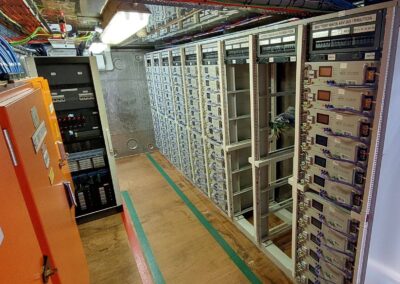A guide to DC Power Systems and DC Power UPS
The definition of a DC power system
So, what is a DC power system? A DC power system can be defined as a power distribution that uses a steady unidirectional current flow between the DC power supply and the load. In simpler terms, the ‘DC’ in DC power stands for direct current, and is where the current flows in one direction continuously. AC stands for alternating current, and is where the current inverts its direction periodically.
How is DC power created from AC?
DC power can be created from AC power, simply by rectifying the AC waveform and filtering the output to remove the AC ripple.
DC power usage
What is a DC power system typical usage case? With the exception of motors, most load equipment ultimately uses DC power internally, regardless of the power source.

Efficiency benefits of DC power systems
Designing a whole power system to be fully DC has greater efficiency than using DC to AC, then AC to DC conversions. Common DC power nominal voltages are 12, 24, 48 and 110VDC.
Modern IT Server rooms are recognizing this efficiency by using 48VDC power input server equipment, instead of the traditional AC. The advantages of this are to eliminate the inefficiencies of AC UPSs, by keeping the whole power system DC, as outlined above.
The battery voltage is also typically much lower in the DC UPS, at 48V, which virtually eliminates the arc flash and shock hazards that are associated with traditional AC output UPS units.
DC power systems vs AC power for voltage safety
Although DC power systems can shock you, DC power is generally considered less dangerous than AC, as can be seen in the ELV (Extra Low Voltage) limits of 50V for AC and 120V for pure DC. The definition of an Extra Low Voltage limit is the range within which carries a low risk of electrical shock. The ELV upper limit for AC of 50V is much lower than that of pure DC’s upper limit at 120V, illustrating the voltage safety comparison in a general sense.
As with AC power, DC power can kill you if the voltage is high enough. DC voltages greater than the ELV limit of 120 VDC should be regarded as dangerous to personnel, particularly in moist situations or hot and sweaty climates. Traditional AC output UPS battery strings are nearly all in this more dangerous, higher voltage category.
DC power vs AC power applications
There are negligible differences between the AC and DC power distribution cabling requirements for similar voltages. DC power systems are typically used where safety, storage, efficiency, or low interference noise is a primary consideration. DC can be efficiently distributed, and wire sizing either way will depend on the current flowing, and voltage drop calculations. The distance DC power can be transmitted is only limited by the voltage drop of the power used, unlike AC power where the voltage drop can be significantly higher depending on the power factor of the load. DC systems are inherently a unity power factor.
DC power UPS
A DC power UPS adds a rechargeable battery to the basic DC power source, to give a specified backup time in the event that the main power source fails. The DC power generated can also be from a variety of source devices, for example solar and wind powered systems, where the battery supports the load equipment during the night and during periods of inadequate weather conditions.
A typical DC power UPS will incorporate a DC power distribution panel in its output, with fuses or circuit breakers to limit the current in the load equipment distribution. DC power can sustain arcing at relatively low currents compared to AC, due to the lack of zero crossing to help extinguish the arc and the parasitic inductance of cabling, etc. Some form of current limiting by circuit breakers or fuses is essential in DC systems and should be sized correctly.
Transforming DC power
DC power can be transformed, but only by conversion to AC power first. The typical DC to DC converter is an electronic device that accepts a specified DC input voltage range and converts it to high frequency AC, which passes through a high frequency transformer and, after post rectification of the transformer AC, outputs the new DC voltage. The output voltage is typically regulated to an accurate level and the DCDC converter can also be used to provide load equipment with a constant supply voltage from a variable power source. A typical application where this type of DC power supply is used would be to smooth a solar or wind power generation system to feed a constant supply voltage to critical loads.
Paralleled DC power supplies
DC power supplies can be connected in parallel where more power is required, provided the output voltage is the same from all supplies. The load current sharing of the paralleled supplies will depend on the accuracy of the voltage control in each power supply. The highest voltage supply will supply the most power when there is even a small difference in the output voltages. For this reason, a DC power monitor (controller) is used in modular converter systems to accurately share the power between modules. The controller module monitors the power being delivered by each power supply module in real time, and precisely adjusts each module’s output voltage to share the load current evenly.
Typical modular DC power supplies are used for AC to DC conversion (Rectifiers) or DC to DC conversion (Converters) where the load is more than the capacity of a single module. Multiple modules can be paralleled using this system for the required load power, allowing for extra modules to be added for redundancy where higher system reliability is required. For example, one additional module above what the load requires is termed N+1 redundancy. This means 1 module can fail but the modular power system can still support the load without interruption. N+2 redundancy means 2 modules can fail without affecting the load.
DC power supplies for batteries
DC power supplies can charge batteries, but they must have some form of current limiting. DC power supplies work by regulating their output voltage to a constant level, regardless of the load current. When a battery is connected at a lower voltage than the power supply regulator, the battery will draw excessive current. The DC power supply must be able to limit this current by reducing its output voltage until the battery regains sufficient charge to bring its terminal voltage up to the power supply regulation voltage setting. DC power supplies for batteries used in cyclic applications like solar will usually have a charge voltage profile that boosts the system voltage to a higher level before dropping back to the final setting. The purpose of this is to get as much charge into the battery as possible before the end of the daylight.

DC power supplies ‘without a transformer’
DC power supplies without a transformer are referring to the large iron transformers in simpler equipment. The ‘transformer-less’ DC power supply still has a transformer, but it is a high frequency type that is far smaller and lighter than the 50Hz AC iron core type, and allows lightweight and small physical size power supplies to be realized. These types of power supplies are relatively complex in construction, with electronics that generate the high frequency switching required, but with the advantage of greatly reduced AC ripples in the output and flexible output control. The disadvantage is that the electronic high frequency switching can produce interference to radio systems if not properly designed by the manufacturer.
DC power systems and inverters
A DC power system can supply an AC load requirement with the use of an inverter. Inverters have a wide variety of construction depending on the application. All inverters use some form of switching to convert the steady DC current into an alternating waveform. Some inverters use double conversion where the lower DC input voltage is stepped up to an intermediate DC voltage using a DCDC converter before being switched to the final AC output waveform. This technique saves on size and weight by eliminating the iron core transformer, but is typically not as rugged in performance for demanding applications.
DC Power Systems and DC Power UPS experts
If you have further questions on DC Power UPS, DC power systems, or need help answering questions like, ‘what is a DC power system that will work with my application? or, ‘are DC power systems or AC power systems best for my situation?’ our expert team at Power On Australia are here to help. Get in touch with us today and we will be more than happy to assist you with your queries.




